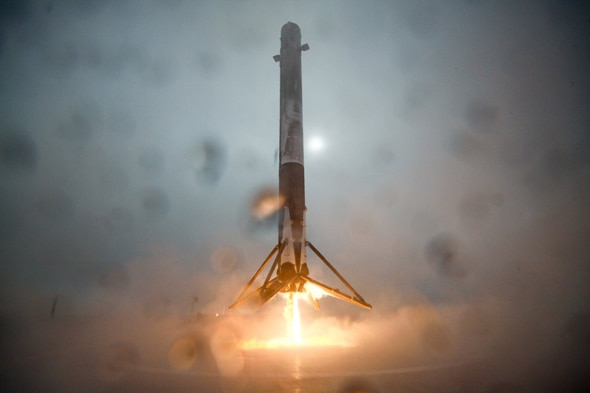Create a free profile to get unlimited access to exclusive videos, sweepstakes, and more!
SpaceX Almost Lands the Falcon 9 Rocket Booster at Sea. Almost.

Sunday, SpaceX successfully launched a Falcon 9 rocket into space, carrying the critically important Jason-3 Earth-observing satellite into orbit. That was the primary mission of the launch, and it went smoothly and perfectly.
Not surprisingly, most people were more excited for the secondary mission, which was to bring the first stage booster back down to Earth. This went pretty well in December, when the booster was brought back down to a landing pad at Cape Canaveral, Florida.
This time, though, they had to land on a floating platform out to sea, on an automated drone ship the size of an American football field, 300 kilometers west of San Diego. Despite heaving waters with 3 to 4 meter waves (!), the booster found the platform, centered itself, came in to land … and then this happened.
Oof. Elon Musk speculated that a collet (a rotating clamp similar to a chuck on a drill that attaches telescoping rods together) on one of the landing legs didn’t secure it tightly enough. When the booster put weight on the leg, it collapsed, and down she went. The root cause may be condensation that got in there from the thick fog at launch, which then froze in the upper atmosphere. Mind you, this is speculation! I’m sure SpaceX will examine the debris very closely to see what’s what.
Like the other two at-sea landings, this one was heartbreaking close, and still an astonishing achievement. Why?
Boosting a satellite into orbit takes a lot of speed. It needs to be moving at about 8 km/sec, or nearly 30,000 kph (18,000 mph) to reach orbit. The first stage booster gets the whole rocket moving as rapidly as possible, then is dropped as dead weight. This lightens the load, so the second stage is pushing much less mass, meaning it can accelerate harder.
That first stage booster has to flip over in space, use the little bit of fuel left over to slow from more than 6,000 kph, fall back to Earth from more than 100 kilometers in altitude, find the floating platform, guide itself there using steerable fins on its sides, deploy the landing legs, then ignite the engine again to slow for the final touchdown.
It’s a freakin’ technological triumph that they can get anywhere near a landing. And as any engineer will tell you, a failure is just a lesson in the steps to getting it right. Yes, this didn’t work, and the booster exploded. But once the reason for that is found, it’ll be fixed and hopefully it won’t happen again (at least for that reason).
The booster that landed successfully in December has been examined, including fueling it up and test-firing it while strapped down. It performed well, though one engine had a fluctuating thrust (the cause of which is still being investigated). It’s hard to say how much work will go into reusing these first stage boosters, but given they cost $60 million to build from scratch, reusing them will save a big chunk of launch cost. That’s why I’m so excited for this work. Reducing launch cost means making access to space easier, and that’s incredibly important.
And again, don’t lose sight of the successful launch of Jason-3, which will measure the effects of climate change on sea level rise and ocean currents. We have another set of eyes in the sky observing our planet, and the more of those, the better.


























